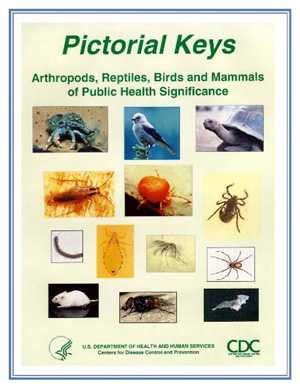Pictorial Keys to Arthropods, Reptiles, Birds, and Mammals of Public Health Significance
This website is archived for historical purposes and is no longer being maintained or updated.
Important Notice
This document is provided by the National Center for Environmental Health’s Environmental Health Services Branch ONLY as an historical reference for the public health community. These PDFs are not maintained and the data they contain may no longer be current and/or accurate.
Public health biologists are often responsible for teaching animal identification to personnel (sanitarians, engineers, physicians, veterinarians, etc.) without special training in taxonomy. One of the most successful devices for such training has been the pictorial key. The first U.S. Public Health Service pictorial key was devised by Stanley B. Freeborn and Eugene J. Gerberg (1943) to guide personnel in the identification of anopheline mosquito larvae during our national malaria control program.
After the Centers for Disease Control and Prevention (CDC) was founded (1946) additional keys were developed. At present the CDC utilizes more than 75 such keys in its regular training program. These are the major items incorporated into this booklet. Apropos morphological diagrams are also included.
Precise identification of disease vectors is essential to their efficient control. In using the following keys it should be remembered that only a few of them include all species in a group, and that determinations made using them are only tentative. The pictorial keys are typical of identification keys found in reference works and scientific papers except that they are arranged as diagrams and are illustrated.
Note: This publication was previously issued under the same title by the Center for Disease Control of the U.S. Public Health Service, Atlanta, Georgia. These files are reproductions from the original publication. The publication has not been updated.
Please click on items below to take you to each section. All of the sections are in Portable Document Format (PDF) and require the Adobe Acrobat Reader. Get the Free Adobe Acrobat Reader.
TABLE OF CONTENTS

Introduction [PDF - 440 KB]
General [PDF - 791 KB]
Crustacea [PDF - 504 KB]
Centipedes [PDF - 510 KB]
Millipedes [PDF - 510 KB]
Arachnida [PDF - 505 KB]
Spiders [PDF - 505 KB]
Scorpions [PDF - 505 KB]
Acarina [PDF - 922 KB]
Ticks [PDF - 922 KB]
Mites [PDF - 922 KB]
Silverfish [PDF - 923 KB]
Collembola [PDF - 859 KB]
Cockroaches [PDF - 864 KB]
Termites [PDF - 859 KB]
Earwigs [PDF - 859 KB]
Psocids [PDF - 859 KB]
Lice (Anoplura) [PDF - 2 MB]
Lice (Mallophaga) [PDF - 166 KB]
Bugs [PDF - 354 KB]
Lepidoptera [PDF - 354 KB]
Beetles [PDF - 353 KB]
Hymenoptera [PDF - 1.2 MB]
Flies [PDF - 677 KB]
Mosquitoes [PDF - 1.7 MB]
Fleas [PDF - 376 KB]
Snakes [PDF - 845 KB]
Birds [PDF - 845 KB]
Rodents [PDF - 845 KB]
Lagomorphs [PDF - 845 KB]
Bats [PDF - 849 KB]
Selected References [PDF - 845 KB]
- Page last reviewed: March 14, 2013 (archived document)
- Content source:


 ShareCompartir
ShareCompartir